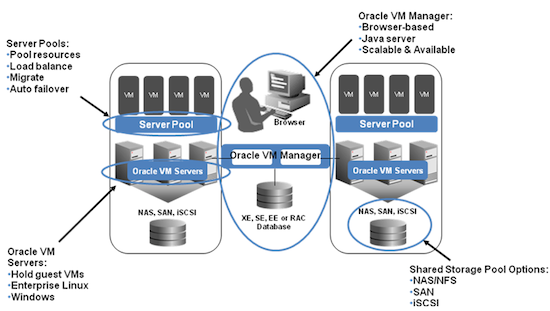As I’ve mentioned in the first article of this series, I do want to delve more deeply into topics from my OOW’09 E-Business Suite Virtualization Update presentation. Before I do that, I wanted to spend some time on our latest EBS 12.1.1 Oracle VM (OVM) Templates.
Rolling Your Own Apps Templates using Oracle VM
In addition to using our templates, customers might want to build their own templates. As most of you know, virtualization platforms like Oracle VM are just that — platforms. They do not help you with anything inside the template, or if they do, it is a starting point template with OS e.g. OVM templates for Oracle Enterprise Linux, or a process/tool to create that OS starting point (JEOS = Just Enough Operating System, pronounce “juice”).

Multiple VMs May Have Naming and IP Collisions
If you
want to bring up a number of these VMs from the same template, they
will all think they are host x with IP y and EBS instance z. That might
cause some problems with your network, or at least for the browser
which needs to figure out how to connect to the right one of these
instances…
If you want to do external integrations, e.g. break
apart your EBS VM’s into a database VM and middle tier VM, or add an
external identity management system, portal, business intelligence, or
whatever you fancy, well that is doable the first time for the first
VM. For the next VM of that template, it might appear like that
integration is already done. Hmmm….
When I brought down the
first VM, did I want to keep it and its integrations around, or not?
Is my middle tier X supposed to work only with one database VM Y or
some another database VM?
Initializing New Virtual Machines Upon First Startup
As
you can see, virtualization platforms only provided the magic to create
more “virtual” machines from one template. But you still need more
magic: for starters, you want the to tell the VM its name and IP to
initialize it when it boots from a template for the first time.
Luckily for both of us, the Oracle VM/Linux team supplies scripts for
this magic. Now, you realize that you really don’t care about virtual
machines, but virtual E-Business Suite instances. You need more magic
to get the E-Business Suite instance to initialize on first boot.
We
have created this magic (OK, it’s just a couple of scripts), for our
E-Business Suite templates, and are eager to share it with you via our
E-Business Suite Virtualization Kit. The Virtualization Kit consists of
documentation and scripts that help automate the desired behavior of
OVM templates with E-Business Suite:
- Oracle VM Template Developers Guide For Oracle E-Business Suite (Note 677681.1)
- Virtualization Kit Scripts for E-Business Suite OVM Templates (Patch 9207542)
Knowledge Document will give you a cookbook approach to building your
own E-Business Suite template, and the patch delivers the magic sauce,
I mean scripts.
Your Feedback is Welcome
We’re
extremely interested in hearing about your use cases and your
experiences with our new E-Business Suite Virtualization Kit. Tell us
what you think via our new OVM Templates discussion forum.
Related Articles
- Part 1: E-Business Suite 12.1.1 Templates for Oracle VM Now Available
- Part 2: Using Oracle VM with Oracle E-Business Suite Virtualization Kit
- Part 3: On Clouds and Virtualization in EBS Environments (OpenWorld 2009 Recap)
- Part 4: Deploying E-Business Suite on Amazon Web Services Elastic Compute Cloud
- Part 5: Live Migration of EBS Services Using Oracle VM
